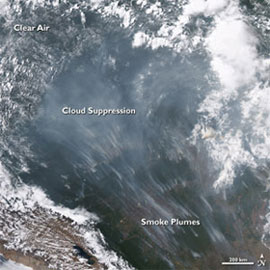Cloud formation linked to air pollution
Cloud formation linked to air pollution
NASA
July 13, 2006
NASA scientists have determined that the formation of clouds is affected by the lightness or darkness of air pollution particles. This also impacts Earth’s climate.
In a breakthrough study published today in the online edition of Science, scientists explain why aerosols — tiny particles suspended in air pollution and smoke — sometimes stop clouds from forming and in other cases increase cloud cover. Clouds not only deliver water around the globe, they also help regulate how much of the sun’s warmth the planet holds. The capacity of air pollution to absorb energy from the sun is the key.
“When the overall mixture of aerosol particles in pollution absorbs more sunlight, it is more effective at preventing clouds from forming. When pollutant aerosols are lighter in color and absorb less energy, they have the opposite effect and actually help clouds to form,” said Lorraine Remer of NASA’s Goddard Space Flight Center, Greenbelt, Md. Remer worked closely with the study’s lead author, the late Yoram Kaufman of Goddard, on previous research into this perplexing “aerosol effect.”
With this new understanding, scientists working to predict how the Earth’s climate is changing will be able to take a big step forward. The effect of the planet’s constantly changing cloud cover has long been a problem for climate scientists. How clouds change in response to greenhouse-gas warming and air pollution will have a major impact on future climate.
Using this new understanding of how aerosol pollution influences cloud cover, Kaufman and co-author Ilan Koren of the Weizmann Institute in Rehovot, Israel, estimate the impact world-wide could be as much as a 5 percent net increase in cloud cover. In polluted areas, these cloud changes can change the availability of fresh water and regional temperatures.
In previous research by the authors and their colleagues, both effects that aerosols have on clouds were seen with data from NASA satellites. Over the northern Atlantic Ocean, clouds that often produce heavy rain storms grew taller and were more frequent when plumes of pollution from North America or dust from Africa’s Sahara Desert were present. However, when smoke from large fires billowed into the sky over South America’s Amazon River basin, clouds were consistently fewer than when the air was relatively clear.

Large plumes of smoke can act as “cloud killers” because the tiny particles in this form of air pollution absorb a lot of sunlight. NASA’s Aqua satellite caught this cloud-suppression process in action over western Brazil and Bolivia in September 2005. Credit: NASA Smoke from forest fires reduces rainfall and spells trouble for the Amazon rainforest |
With these observations alone, the scientists could not be absolutely sure that the aerosols themselves were causing the clouds to change. Other local weather factors such as shifting winds and the amount of moisture in the air could have been responsible, meaning the pollution was just along for the ride.
“Separating the real effects of the aerosols from the coincidental effect of the meteorology was a hard problem to solve,” said Koren. In addition, the impact of aerosols is difficult to observe, compared to greenhouse gases like carbon dioxide, because aerosols only stay airborne for about one week, while greenhouse gases can linger for decades.
To tackle this problem, Kaufman and Koren assembled a massive database of global observations that strongly suggests it is the darkness (absorbs sunlight) or brightness (reflects sunlight) of aerosol pollution and not weather factors that cause pollution to act as a cloud killer or a cloud maker. These measurements were culled from the NASA-sponsored Aerosol Robotic Network of ground-based instruments at nearly 200 sites worldwide.
The scientists conducted an extensive survey of sky conditions at 17 locations (including Washington, Rome, Beijing, and Mexico City) that represented different types of air pollution and weather patterns. Automated instruments that act like a camera’s light meter to record how much sunlight was coming from the sky took readings several times an hour at different times of the year.
No matter where in the world the measurements were taken or in what season, Kaufman and Koren saw the same pattern. There were lots of clouds when light-reflecting pollution filled the air, but many fewer clouds were recorded in the presence of light-absorbing aerosols. “The probability that such a consistent relationship between aerosols and their effects on clouds is due to some other factor is very unlikely,” said Koren.
NASA’s satellites, computer models, and technology will continue to advance our understanding of how aerosol pollution affects the Earth’s climate. NASA’s “A-Train” of formation flying satellites, now with the cloud-piercing instruments onboard the Cloudsat and CALIPSO spacecrafts, are helping answer challenging questions such as the role of clouds in global warming and the influence of aerosols on rainfall and hurricanes.
This is a modified press release from NASA.













